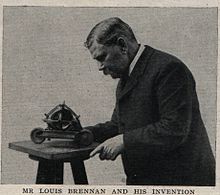Louis Brennan
|
Louis Brennan CB |
|
|---|---|

Louis Brennan with a demonstration model
|
|
| Born |
28 January 1852 Castlebar, Ireland |
| Died | 17 January 1932 (aged 79) Montreux, Switzerland |
| Cause of death | Motor vehicle accident |
| Resting place |
St. Mary's Roman Catholic Cemetery, Kensal Green, London 51°31′47″N 0°13′44″W / 51.529679°N 0.228953°W |
| Nationality | Irish-Australian |
| Occupation | Mechanical engineer and inventor |
| Known for | Inventor of the steerable Brennan Torpedo |
Louis Brennan CB (28 January 1852 – 17 January 1932) was an Irish-Australian mechanical engineer and inventor.
Brennan was born in Castlebar, Ireland, and moved to Melbourne, Australia in 1861 with his parents. He started his career as a watchmaker and a few years later was articled to Alexander Kennedy Smith, a renowned civil and mechanical engineer of the period. He served as a sergeant in the Victorian Engineers under the command of Captain J. J. Clark. Brennan invented the idea of a steerable torpedo in 1874, from observing that if a thread is pulled on a reel at an angle with suitable leverage, the reel will move away from the thread side. Brennan spent some years working out his invention, and received a grant of £700 from the Victorian government towards his expenses. He patented the Brennan Torpedo in 1877. The idea was trialled at Camden Fort near Crosshaven, Cork, Ireland.
Brennan went to England in 1880 and brought his invention before the War Office. Sir Andrew Clarke alerted the authorities to the possibilities of the torpedo if used in the defence of harbours and channels, and the patent was eventually bought for a sum believed to be more than £100,000. In 1887 Brennan was appointed superintendent of the Brennan torpedo factory, and was consulting engineer 1896–1907.
He did much work on a monorail locomotive which was kept upright by a gyrostat. In 1903 he patented a gyroscopically-balanced monorail system that he designed for military use; he successfully demonstrated the system on 10 November 1909, at Gillingham, England, but fears that the gyroscopes might fail prevented adoption of the system for widespread use.
...
Wikipedia
